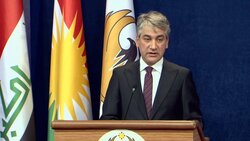Three proposals to prevent "open war" and an alternative Iraqi-Gulf plan

Shafaq News / On 3 January, over 300 innocent civilians were killed or injured in a terror attack in the Iranian city of Kerman, after crowds had gathered to commemorate the fourth anniversary of former Iranian commander Qassem Soleimani’s death in a US air strike.
On 4 January, a drone strike killed four Iraqi militia members and wounded six others in Baghdad. Iraqi authorities blamed the US-led international coalition.
On Christmas Day, Israel assassinated Sayyed Razi Mosusavi, the most senior Iranian commander in Syria. It followed up with the assassination of Hamas deputy leader Saleh al-Arouri, killed in a Beirut blast. Lebanon’s prime minister accused Israel of trying to "drag" it into a regional war.
Since October, Israel has continued its attacks across the Gaza Strip, causing horrible casualty figures. As of 3 January, more than 90,000 Palestinians and 2,500 Israelis have been either killed or injured, 75 percent of Gaza’s 2.3 million inhabitants have been displaced, and 335,000 residential homes in Gaza have been destroyed or badly damaged.
This is all happening in a place that the United Nations deemed “unlivable” before the war began, due to Israel’s devastating blockade that stretches back to 2007.
Since October, the Israeli army has dropped over 65,000 tonnes of explosives on the Gaza Strip, four times the power of the nuclear bomb the US dropped on the Japanese city of Hiroshima.
Regional war
US troops in Iraq and Syria have come under attack over 100 times. The US military has carried out multiple retaliatory air strikes in Iraq and Syria against Iran-aligned militants.
These clashes demonstrate how the fallout from the Israel-Hamas war is rippling across the Middle East.
“Israel wants to expand the war into Lebanon and appears to welcome open warfare against the so-called axis of resistance - Hezbollah in Lebanon, the Houthis in Yemen, and the revolutionary government in Iran,” said Trita Parsi, the executive vice president of the Quincy Institute.
A regional war would be a disaster for the region, the international community, and even for Israel. Therefore, multiple actions are needed to contain such an imminent threat.
The first and most important step is a ceasefire between Israel and Hamas, with the US the only country with the leverage to push Israeli Prime Minister Benjamin Netanyahu to accept a sustainable ceasefire.
“All of our missiles, the ammunition, the precision-guided bombs, all the airplanes and bombs, it’s all from the US," said a retired Israeli major general, Yitzhak Brick.
"The minute they turn off the tap, you can’t keep fighting. You have no capability… Everyone understands that we can’t fight this war without the United States. Period.”
The Biden administration voted a UN ceasefire resolution that only 10 out of 186 nations opposed, while multiple human rights groups in and outside of Israel - as well as a former head of the Mossad - have concluded that Palestinians are living under a system of apartheid. Joe Biden needs to change course.
The second vital step is sustainable peace between Israel and the Palestinians. This would require the implementation of the UN's resolutions on the two-state solution, to end 75 years of Palestinian displacement and occupation.
The Middle East will never be secure or stable without achieving a just and comprehensive solution to the Palestinian crisis. Here again, the US is the only country that can force Israel to accept a fair and just peace with Palestinians.
Attacking Iran
Israel’s long-term strategy is to convince the US to attack Iran.
“The US and Israel need to take Iran on directly,” former Israeli prime minister, Naftali Bennett, wrote in the Wall Street Journal on 28 December.
In May 2018, despite Iran’s full compliance with the Joint Comprehensive Plan of Action (JCPOA) over three years, President Donald Trump withdrew the US from the nuclear deal and pursued a maximum-pressure strategy consisting of economic, political, and military pressure against Iran to get a “better deal”.
Netanyahu claimed he had convinced Trump to withdraw from the Iran deal.
The third key step is to contain the current tensions between the US and Iran. Getting the 2015 nuclear accord back on track was a top goal for Biden after Iran ended its compliance with the JCPOA three years after Trump’s withdrawal.
Washington and Tehran reached an agreement mediated by Qatar and Oman, by which $6bn in frozen Iranian funds was released to Qatar, to be used for Iran’s humanitarian requirements.
The US and Iran also each released five American-Iranian prisoners as part of the deal.
Iran agreed to curb its accumulation of highly enriched uranium, allow increased international inspections of its nuclear facilities, and halt its proxies’ attacks on US forces in the Middle East.
In return, Tehran would be allowed to export more oil and Iran’s funds in Iraq would be gradually released.
Israel's war on Gaza has, however, killed the temporary agreement between Iran and the US. "Because of the Israeli-Hamas war, Americans are not going to continue negotiations with Iran, the JCPOA is dead, nuclear diplomacy with Iran is dead," one European official told me. "The US asked the Qatari government to ask Iran not to ask for the $6bn in the current circumstance," he added.
Collision course
The US House of Representatives passed a bipartisan measure on 30 November to block Iran from ever accessing the $6bn.
Washington and Tehran are on a collision course. In addition to the escalation of the regional clashes, the Biden administration continues to issue new sanctions against Iran and, in response, Tehran continues to escalate its nuclear program.
Based on the most recent IAEA report, Iran’s stock of uranium enriched to up to 60 percent is theoretically enough for three nuclear bombs.
As the war in Gaza goes on, and in the absence of US-Iran talks and the failure to revive the Iran nuclear deal, the possibility of regional escalation is greater than it has been in years.
Moreover, an end to decades of US-Iran confrontation is required to achieve sustainable peace and stability in the Middle East.
The leaders of the US and Iran need to find the courage to engage in a broad dialogue to achieve a comprehensive deal, including reviving the temporary agreement and the JCPOA and resolving all other disputed issues.
If this is unrealistic, the eight countries around the Persian Gulf - Iran, Saudi Arabia, Iraq, the United Arab Emirates, Qatar, Oman, Kuwait, and Bahrain - need to strike a grand regional deal on a new security and cooperation structure in the Gulf that includes a regional nuclear deal and a region free from nuclear weapons and all weapons of mass destruction.
(Middle East Eye)





